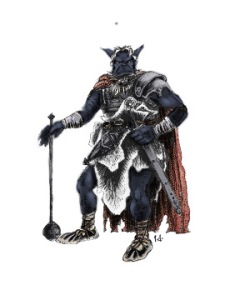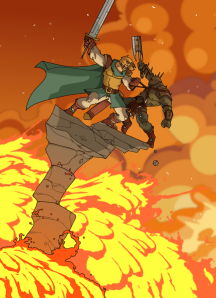Monsters and Treasures
Okay, so I’ve been writing other stuff for awhile now, and
I’ve been neglectful of this little series of naked hubris. So back to it with Monsters and Treasure,
Volume 2 of OD&D.
The table that opens the book displays its wargame roots to
me. Monsters are presented here as a list, rather than as encyclopedia type entries that you see in the Monster Manual and onwards. The former suggests a selection from which to choose, while the latter suggests reference material for something you've already chosen. The entries look to be sorted roughly by
category (undead are together, mean humanoids are together, foresty/fae type
guys are together, et cetera). It would
have been handy for these to have been called out specifically, like we see in
later “encounter by terrain” type tables, but the thought was already there.
Finally, you’ve gotta admire the brevity of the “stat block” given. It even makes S&W’s justly praised
concise stats seem extensive.
Again we see some assumptions that you’re familiar with
Chainmail if you’re bothering to buy this game.
I have to wonder how much of this was just carry over from the document
starting out as “the fantasy supplement” to Chainmail that was never changed, and how much was because
they assumed people buying this new product (D&D) would already be Chainmail
fans (or was it a subtle way to try to “push” Chainmail?).
And as we get into the actual monster descriptions, there
are a few things I find interesting: men are given an extensive treatment
compared to their treatment as “monsters” in later editions. I think this is partly because later editions
figure “we already told you how to make characters and NPCs, you can just do
that for bad guys”, but I think it also reveals a preference for humans as the
“default” opponent that was worn away in favor of monsters and humanoids in
later versions. It makes sense,
considering the game started as “medieval battles (all humans) +
monsters”.
As we get into actual monsters, the brief descriptions focus
entirely on “tactical” considerations, even if they are flavorful (“will attack
dwarves on sight” and so on). There are
some interesting implicit “setting” details that come out, such as detailing
goblin kings and that there are varied tribes of orcs, some in villages, some
in caves. Gnolls and Trolls get a little
bit of pure flavor text.
The tradition of giving Dragons one of the most extended
entries starts early and starts strong (they are in the title, after
all). The “attack/damage modifier by
element type” table is interesting, I had forgotten it was there. Are these retained in later versions, just
spelled out on a by dragon basis? It’s kind of cool seeing it as a “system” of
sorts. Oh, and the “subduing dragons”
section is one of my favorites from OD&D.
When I first found it, I couldn’t believe they had such specific rules
spelled out for dragons only. This
rule just screams “made up for a very specific event in play that became common
place” rather than made up to be complete or to cover everything. It’s also interesting that the dragons choice
of attack is shown as being diced for, rather than decided by the referee.
Overall, for such a tiny booklet, it is surprising to me how
complete the monster list is. So many
monsters that became staples of D&D are right there. It’s pretty admirable, really. Sure, the AD&D 2E Monstrous Manual was
probably the very first gaming book I ever bought from a store (the PHB I got
from a friend), and it is a lovely and inspirational book, but as with the rest
of OD&D, the terse entries presuppose that I can handle detailing stuff and
making it interesting myself, and just give me some help on the stats.
Now, as for the Treasure section, I’ve gotta say, the tables
make my eyes cross a little bit. I’m
sure there’s all sorts of interesting stuff to be gleaned by examining the
probabilities of different outcomes, and I’m sure it supports the whole “dice
tell you what the world is like” mindset that I find it useful to cultivate as
a referee, but I can’t perform that analysis right now. My own preferences for rare magic items have
led me to using other systems, though perhaps I should re-evaluate the
assumptions in the tables about rate of reward to challenge, since I feel like
I’ve gotten off on that in my own game.
The magic sword section is pleasingly detailed and
insane. It’s pretty obvious that Gygax
and Arneson (or their friends) had Stormbringer in mind for a lot of the design
here. It’s also surprising that magic
swords get so much treatment when they’re not super rare by the treasure tables
(I think; again, no in-depth analysis here).
Perhaps this was an early attempt at a solution to “but what makes
fighters special as they level up?” Though the Egoism rules suggest an attempt
at also building in “but how to keep low level fighters from getting too
powerful too quick by one lucky treasure break”. That’s a problem I’m facing
right now in my game, so it wouldn’t surprise me if it’s been there from the
get go at least for some folks.
With the magic items, there is a similar familiarity as seen with monsters, but in this case it is less pleasing to me. This list gives the impression of “here’s
some wacky stuff we thought up either because it would be fun/weird, because it
was in a story we read, or because it came up in play that it would make
sense.” Or at least, that's how the list comes across if I force myself not to read it as “standard D&D
magic items”. Because
all of these became the assumed default magic items, and time changed them from
a list of examples to a list of assumptions to a list of guarantees.
Copper coins are worth a little more, 1/50th
gold, rather than 1/500th.
Interesting. Oh, and I’ve been
doing some research for encumbrance rules, and it turns out that 10 coins to
the pound isn’t that crazy – for silver.
Gold coins were way lighter than silver coins, because the metal was
worth so much more, people made much smaller, thinner coins. I’m finding the “silver standard” of games
like LotFP to make more and more sense.
Plus it adds the chance to make the default coin the heaviest and
hardest to transport, hah!









